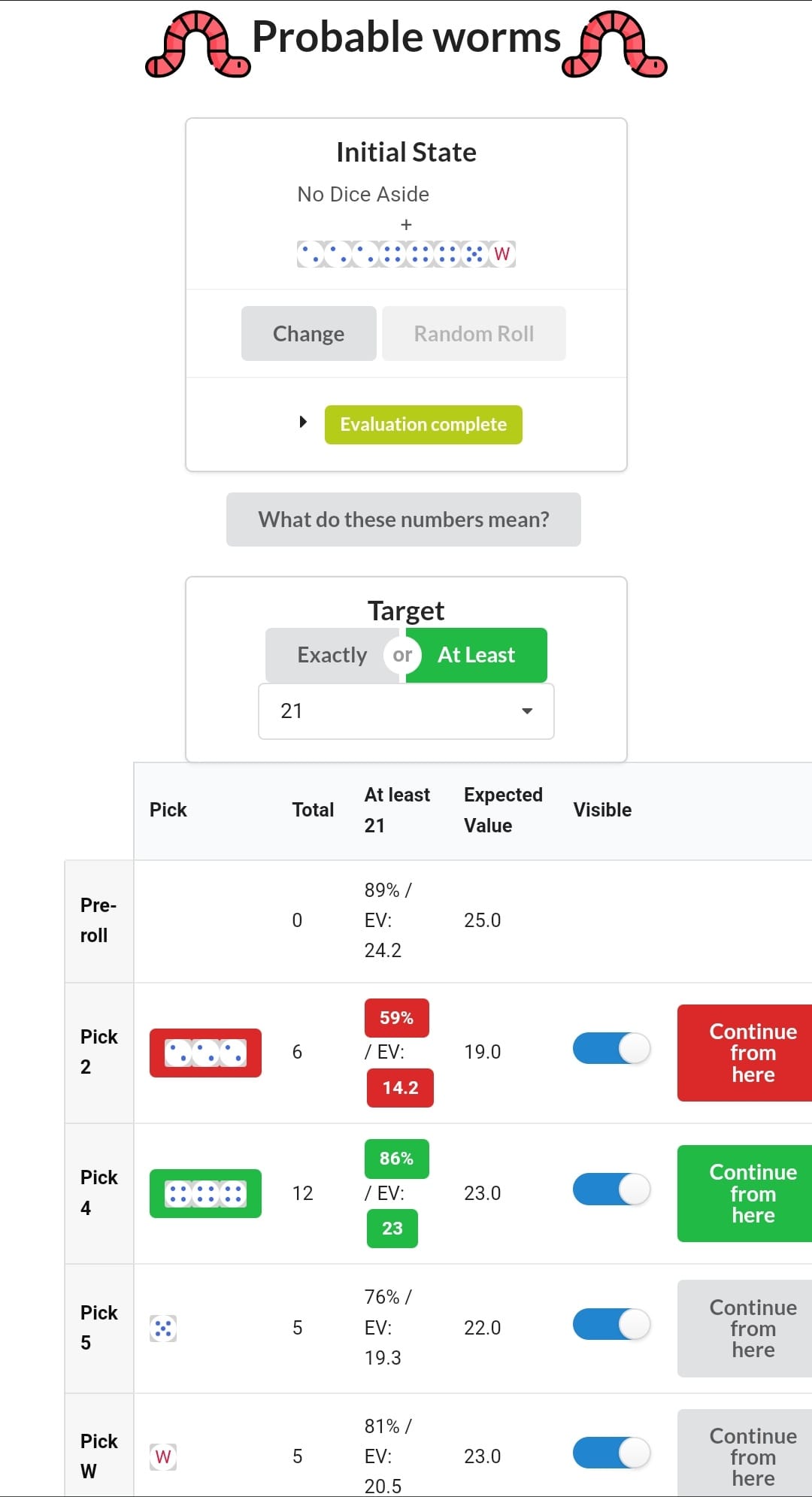probable-worms
A dice calculator for the board game Heckmeck
Check out the webpage

What's the purpose of this tool?
To help with making the optimal choice of dice drafting. It doesn't completely solve the game, but it really simplifies the decision-making process.
You still need to decide which tile(s) to go for, but if you have a picked the target, then this tool will guide you how to get there.
How to use the tool?
Go to the "What do these numbers mean?" page of the webpage to interpret the statistical data collected, and how to make decisions.
How do you evaluate a position?
Figuring out how to evaluate a position was quite difficult, as there isn't a straightforward and simple way to visualise a position's worth. In the end the approach is relatively simple:
Four types of evaluation
We evaluate a state in a few different ways, to accommodate different goals:
- Expected value (EV): what's the average result we can achieve?
- Exactly X probability: what's the probability we can stop at exactly X?
- At least X probability: what's the probability we achieve a result at least X?
- EV of at least X: if we treat results under X as failures, what's our EV?
Two types of "states"
First, we distinguish two "states" of the dice:
- Unrolled state: before rolling the remaining dice
- Rolled state: after rolling the remaining dice, and before choosing an option
Terminal state evaluation
First, we try to evaluate the terminal states, i.e. the states that have no further future. These can come from 3 routes:
- We chose to stop at an unrolled state, e.g. because we want to steal
- We have no more unrolled dice, since we drafted all of them
- The options of a rolled state were dice we had already drafted
In that situation the evaluation is quite simple:
Using T as the total we achieved:
| 1 | 2 | ... | T | |
|---|---|---|---|---|
| Exactly | 0 | 0 | 0 | 100% |
| At least | 100% | 100% | 100% | 100% |
| EV of at least | T | T | T | T |
| EV | T |
This is now the shape of every evaluation we assign to a state
Non-terminal state evaluation
Now we can recursively evaluate any non-terminal state, by combining in one way or another the evaluations of the available next-states.
Rolled state evaluation
After we've rolled our remaining dice, we have a few distinct next-states, and since this is a recursive scheme, they have an evaluation of their own.
To combine them to an evaluation of the rolled state, we don't pick a specific evaluation from the next-states, but calculate each entry in the evaluation table separately, so we end up with a mix of entries from different next-states.
To construct the evaluation table, we pick the maximum value from each next-state evaluation, substituting for 0 if it an evaluation doesn't have a specific value.
This reflects the strategy of picking the specific di(c)e that increase our selected target:
| 1 | ... | |
|---|---|---|
| Exactly | max | max |
| At least | max | max |
| EV of at least | max | max |
| EV | max |
Unrolled state evaluation
Before rolling the remaining dice we have two options:
- Either stop there
- Or decide to roll the dice, that will have a set of next-states with specific probabilities
In the first case the evaluation is known, it's a terminal state.
In the second case, we again calculate each entry independently, reflecting the fact that each outcome can have a different path based on luck.
To construct the evaluation table, we pick the weighted average form each next-state evaluation, substituting for 0 if an evaluation doesn't have a specific value.
Then, we replace the Exactly T entry with 100%, since we can always choose to stop at T.
| 1 | ... | T | ... | |
|---|---|---|---|---|
| Exactly | avg | avg | 100% | avg |
| At least | avg | avg | avg | avg |
| EV of at least | avg | avg | avg | avg |
| EV | avg |
Time to evaluate a position
The time needed to evaluate an 8-dice position in the browser, with a 2015 era laptop are a couple of hours, going to about a minute for a 5-dice position. Positions with 4 dice or fewer can be calculated in less than a second.
We cache 5-dice to 8-dice positions, to have a responsive web app, and calculate 4-dice or fewer positions on the fly.